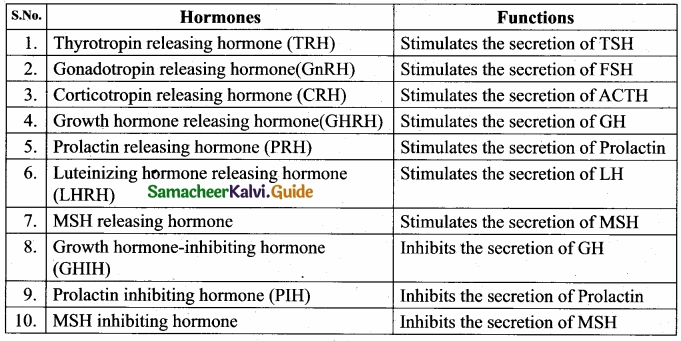Students can Download Tamil Nadu 11th Biology Model Question Paper 5 English Medium Pdf, Tamil Nadu 11th Biology Model Question Papers helps you to revise the complete Tamilnadu State Board New Syllabus, helps students complete homework assignments and to score high marks in board exams.
TN State Board 11th Biology Model Question Paper 5 English Medium
General Instructions:
-
- The question paper comprises of four parts. Questions for Botany and Zoology are asked separately.
- You are to attempt all the parts. An internal choice of questions is provided wherever applicable.
- All questions of Part I, II, III and IV are to be attempted separately.
- Question numbers 1 to 8 in Part I are Multiple Choice Questions of one mark each. These are to be answered by choosing the most suitable answer from the given four alternatives and writing the option code and the corresponding answer.
- Question numbers 9 to 14 in Part II are two-marks questions. These are to be answered in about one or two sentences.
- Question numbers 15 to 19 in Part III are three-marks questions. These are to be answered in about three to five short sentences.
- Question numbers 20 and 21 in Part IV are five-marks questions. These are to be answered in detail. Draw diagrams wherever necessary.
Time: 3:00 Hours
Maximum Marks: 70
Bio – Botany [Maximum Marks: 35]
PART – I
Answer all the questions. Choose the correct answer. [8 × 1 = 8]
Question 1.
The term bacterium was coined by ………………………
(a) Stanley
(b) Ehrenberg
(c) Gram
(d) Koch
Answer:
(b) Ehrenberg
![]()
Question 2.
Which of the following components provides sticky character to the bacterial cell?
(a) Cell wall
(b) Nuclear membrane
(c) Plasma membrane
(d) Glycocalyx
Answer:
(d) Glycocalyx
Question 3.
Number of floral parts per whorl is called ……………………
(a) Curosity
(b) Atrocity
(c) Merosity
(d) Porosity
Answer:
(c) Merosity
![]()
Question 4.
“The evolution and classification of flowering plants” – book was written by ………………..
(a) Engler & Prantl
(b) Bentham & Hooker
(c) Cronquist
(d) Theophrasthus
Answer:
(c) Cronquist
Question 5.
Lainpbrush chromosomes occur at ………………….. stage of meiotic Prophase I.
(a) Leptotene
(b) Diplotene
(c) Zygotene
(d) Pachytene
Answer:
(b) Diplotene
Question 6.
Who is called as father of plant physiology?
(a) J.C. Bose
(b) Stephen Hales
(c) Dixon
(d) Unger
Answer:
(b) Stephen Hales
Question 7.
Pitcher plant is the common name for ……………………..
(a) Drosera
(b) Nepenthes
(c) Utricularia
(d) Dionaea
Answer:
(b) Nepenthes
![]()
Question 8.
Chemiosmotic theory was proposed by ………………………
(a) Mitchell
(b) Hatch & Slack
(c) Calvin
(d) Priestley
Answer:
(a) Mitchell
PART – II
Answer any four of the following questions. [4 × 2 = 8]
Question 9.
What is mycorrhiza?
Answer:
The symbiotic association between fungal mycelium and roots of plants is called as mycorrhiza.
![]()
Question 10.
Why do roots modify their structure? Name the types of root modification?
Answer:
Roots modify their structure to perform secondary functions. The two types of root modification are tap root modification and fibrous root modification.
Question 11.
Name any 4 sub classes of Liliopsida?
Answer:
- Alismatidae
- Arecidae
- Commelinidae
- Zingiberidae
Question 12.
How vacuoles helps to maintain the structure of a plant cell?
Answer:
The major function of plant vacuole is to maintain water pressure known as turgor pressure, which maintains the plant structure.
![]()
Question 13.
Compare Active transport with Passive transport?
Answer:
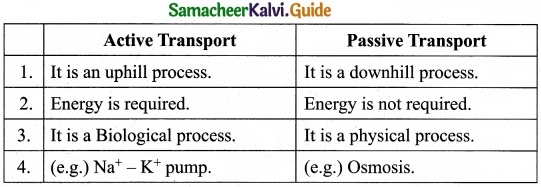
Question 14.
How will you define Quantasomes?
Answer:
Quantasomes are the morphological expression of physiological photosynthetic units, located on the inner membrane of thylakoid lamellae.
PART – III
Answer any three questions in which question number 19 is compulsory. [3 × 3 = 9]
Question 15.
Classify lichens based on morphology?
Answer:
- Leprose – Absence of distinct fungal layer
- Crustose – Crust – like
- Foliose – Leaf – like
- Fruticose – Branched pendulous shrub – like
![]()
Question 16.
“Roots perform photosynthesis”-Justify with example?
Answer:
Roots of some climbing or epiphytic plants develop chlorophyll and turn green which help in photosynthesis. These roots are called as photosynthetic roots, e.g,,Tinospora.
Question 17.
Differentiate Apocarpous and Syncarpous ovary?
Answer:
- Apocarpous: A pistil contains two or more distinct carpels. Example: Annona
- Syncarpous: A pistil contains two or more carpels which are connate. Example: Citrus and Tomato
![]()
Question 18.
Draw & label the ground plan of T.S. of Dicot root?
Answer:
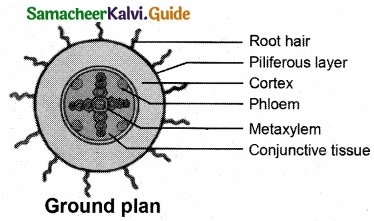
Question 19.
What do you mean by Respiratory substrate? Give example?
Answer:
Respiration is a biological process in which oxidation of various food substances like carbohydrates, proteins and fats take place and as a result of this, energy is produced where O2 is taken in and CO2 is liberated. The organic substances which are oxidised during respiration are called respiratory substrates.
PART – IV
Answer all the questions. [2 × 5 = 10]
Question 20.
Define phyllotaxy. Explain its type?
Answer:
The mode of arrangement of leaves on the stem is known as phyllotaxy (Greek. Phyllon = leaf; taxis = arrangement). Phyllotaxy is to avoid over crowding of leaves and expose the leaves maximum to the sunlight for photosynthesis. The four main types of phyllotaxy are:
- Alternate
- Opposite
- Temate and
- Whorled.
1. Alternate phyllotaxy:
In this type there is only one leaf per node and the leaves on the successive nodes are arranged alternate to each other. Spiral arrangement of leaves show vertical rows are called orthostichies. They are two types:
- Alternate spiral: In which the leaves are arranged alternatively in a spiral manner. e.g., Hibiscus and Ficus.
- Alternate distichous or Bifarious: In which the leaves are organized alternatively in two rows on either side of the stem, e.g., Monoon longifolium (.Polyalthia longifolia).
2. Opposite phyllotaxy:
In this type each node possess two leaves opposite to each other. They are organized in two different types:
(I) Opposite superposed:
The pair of leaves arranged in succession are in the same direction, that is two opposite leaves at a node lie exactly above those at the lower node, e.g., Psidium (Guava), Eugenia jambolana (Jamun) and Quisqualis (Rangoon creeper).
(II) Opposite decussate:
In this type of phyllotaxy one pair of leaves is placed at right angles to the next upper or lower pair of leaves, e.g., Calotropis, Zinnia and Ocimum
3. Ternate phyllotaxy:
In this type there are three leaves attached at each node, e.g., Nerium.
4. Whorled (verticillate) type of phyllotaxy:
In this type more than three leaves are present in a whorl at each node forming a circle or whorl, e.g., Allamanda and Alstonia scholaris.
[OR]
Distinguish between prokaryotes and eukaryotes?
Answer:
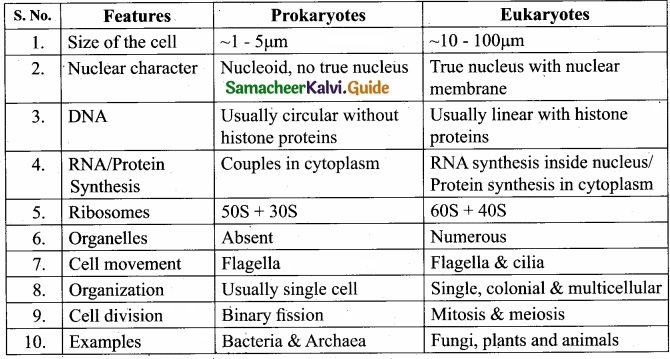
![]()
Question 21.
Explain the insectivorous mode of nutrition in angiosperms?
Answer:
Insectivorous mode of nutrition:
Plants which are growing in nitrogen deficient areas develop insectivorous habit to resolve nitrogen deficiency.
1. Nepenthes (Pitcher plant):
Pitcher is a modified leaf and contains digestive enzymes. Rim of the pitcher is provided with nectar glands and acts as an attractive lid. When insect is trapped, proteolytic enzymes will digest the insect.
2. Drosera (Sundew):
It consists of long club shaped tentacles which secrete sticky digestive fluid which looks like a sundew.
3. Utricularia (Bladder wort):
Submerged plant in which leaf is modified into a bladder to collect insect in water.
4. Dionaea (Venus fly trap):
Leaf of this plant modified into a colourful trap. Two folds of lamina consist of sensitive trigger hairs and when insects touch the hairs it will close.
[OR]
List out the physiological effects of Abscissic acid?
Answer:
- It helps in reducing transpiration rate by closing stomata. It inhibits K+ uptake by guard cells and promotes the leakage of malic acid. It results in closure of stomata.
- It spoils chlorophylls, proteins and nucleic acids of leaves making them yellow.
- Inhibition of cell division and cell elongation.
- ABA is a powerful growth inhibitor. It causes 50% inhibition of growth in Oat coleoptile.
- It induces bud and seed dormancy.
- It promotes the abscission of leaves, flowers and fruits by forming abscission layers.
- ABA plays an important role in plants during water stress and during drought conditions. It results in loss of turgor and closure of stomata.
- It has anti – auxin and anti – gibberellin property.
- Abscisic acid promotes senescence in leaves by causing loss of chlorophyll pigment decreasing the rate of photosynthesis and changing the rate of proteins and nucleic acid synthesis.
Bio – Zoology [Maximum Marks: 35]
PART – I
Answer all the questions. Choose the correct answer. [8 × 1 = 8]
Question 1.
Cladogram consists the following characters …………………….
(a) Physiological and Biochemical
(b) Evolutionary and Phylogenetic
(c) Taxonomic and systematic
(d) None of the above
Answer:
(b) Evolutionary and Phylogenetic
![]()
Question 2.
The limbless amphibian is ………………………
(a) Hyla
(b) Rana
(c) Icthyophis
(d) Salamander
Answer:
(c) Icthyophis
Question 3.
ECG stands for …………………….
(a) Electro Cardiogram
(b) Electro Caplaris gram
(c) Electro Carrying gram
(d) Electro ensephalo gram
Answer:
(a) Electro Cardiogram
![]()
Question 4.
Match the List – I and List – II
|
List – I |
List – II |
| 1. Tidal Volume | (i) 1100 to 1200 ml |
| 2. Residual Volume | (ii) 500 ml |
| 3. Expiratory reserve Volume | (iii) 2500 to 3000 ml |
| 4. Inspiratory reserve Volume | (iv) 1000 to 1100 ml |
(a) 1 – (i), 2 – (ii), 3 – (iii), 4 – (iv)
(b) 1 – (ii), 2 – (i), 3 – (iv), 4 – (iii)
(c) 1 – (ii), 2 – (iv), 3 – (i), 4 – (iii)
(d) 1 – (iv), 2 – (iii), 3 – (i), 4 – (ii)
Answer:
(b) 1 – (ii), 2 – (i), 3 – (iv), 4 – (iii)
Question 5.
Which of the following is correct statement?
(a) All the reptiles have a three chambered heart.
(b) All mammals are viviparous.
(c) All cyclostomes do not posses jaws and paired fin.
(d) All pisces have gills covered by a operculum.
Answer:
(c) All cyclostomes do not posses jaws and paired fin.
![]()
Question 6.
Which of the following is incorrect statement with regard to peripheral neural system ?
(a) Its pathways innervate skeletal muscles.
(b) Its pathways are usually voluntary.
(c) Its pathways always involve four neurons.
(d) Some of its pathways are referred to as reflex arcs.
Answer:
(c) Its pathways always involve four neurons.
Question 7.
Centers for sense of smell are located …………………..
(a) Cerebellum
(b) Midbrain
(c) Olfactory lobes
(d) Cerebrum
Answer:
(c) Olfactory lobes
![]()
Question 8.
Excess secretion of cortisol leads to ………………………
(a) Addison’s disease
(b) Grave’s disease
(c) Cushing’s syndrome
(d) Gull’s disease
Answer:
(c) Cushing’s syndrome
PART – II
Answer any four of the following questions. [4 × 2 = 8]
Question 9.
Write about the classification of Lampito maurittii?
Answer:
Classification:
- Phylum: Annelida
- Class: Oligochaeta
- Order: Haplotaxida
- Genus: Lampito
- Species: mauritii
![]()
Question 10.
Define indigestion?
Answer:
Indigestion is the digestive disorder in which the food is not properly digested leading to a feeling of fullness of stomach.
Question 11.
Write about muscle fatigue?
Answer:
Muscle fatigue is the inability of a muscle to contract after repeated muscle contractions. This is due to lack of ATP ancl accumulation of lactic acid by anaerobic breakdown of glucose.
![]()
Question 12.
Difference between neutrophils and esinophils?
Answer:
|
Neutrophils |
Eosinophils |
| 1. Neutrophils are polymorphonuclear cells with 3-4 lobes of nucleus connected with delicate threads. | 1. Eosinophils have distinctly bilobed nucleus and the lobes are joined by thin strands. |
| 2. Neutrophils constitute about 60%-65% of the total WBCs. | 2. Eosinophils constitute about 2-3% of the total WBCs. |
![]()
Question 13.
Draw and label the parts of LS of kidney?
Answer:
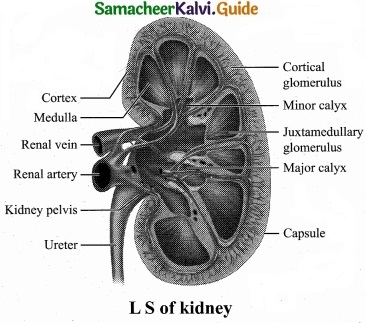
Question 14.
What are the functions of glucagon?
Answer:
Glucagon is a polypeptide hormone. It is a potent hyperglycaemic hormone that acts on the liver and promotes the breakdown of glycogen to glucose (Glycogenolysis), synthesis of glucose from lactic acid and from non-carbohydrate molecules (gluconeogenesis).
Releases glucose from the liver cells, increasing the blood glucose levels. Since glucagon reduces the cellular uptake and utilisation of glucose it is called a hyperglycemic hormone. Prolonged hyperglycemia leads to the disorder called diabetes mellitus.
PART – III
Answer any three questions in which question number 19 is compulsory. [3 × 3 = 9]
Question 15.
Bioluminence is advantageous to ctenophores?
Answer:
Ctenophores are exclusively marine. They emit light. It helps the animals in finding food, mate and excape from the predators.
![]()
Question 16.
How do earthworms breathe?
Answer:
In earthworms, respiration takes place through the body wall by the moist skin diffusion, oxygen diffuses through the skin into the blood while carbon dioxide from the blood diffuse out.
![]()
Question 17.
What is Vermicompost?
Answer:
Vermicompost is the compost produced by the action of earthworms in association with all other organisms in the compost unit.
Question 18.
Differentiate between elastic fibres and elastic connective tissue?
Answer:
|
S.No |
Elastic fibres |
Elastic connective tissue |
| 1. | It contains elastin and other proteins and glycoproteins. | It contains high proportion of elastic fibres. |
| 2. | It attaches muscles and bones and one bone to another bone. | It is found in the walls of large arteries, ligaments associated with vertebral column and within the walls of the bronchial tubes. |
| 3. | It withstands tensile stress when pulling force is applied in one direction or in many direction. | It allows recoil of tissues after stretching. |
![]()
Question 19.
Draw the graph of a normal ECG?
Answer:
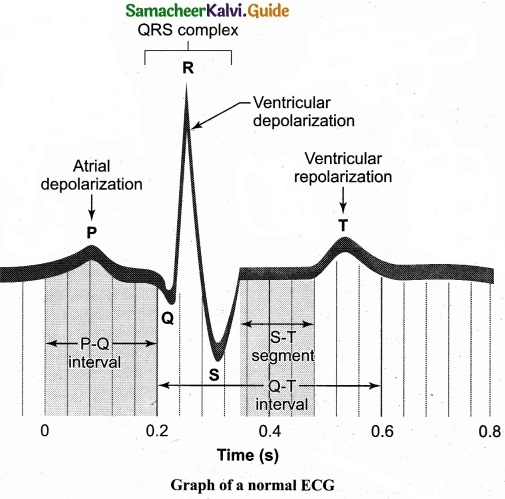
PART – IV
Answer all the questions. [2 × 5 = 10]
Question 20.
Distinguish between chordates and non – chordates?
Answer:
|
Chordates |
Non – chordates |
| 1. Notochord is present | 1. Absence of notochord |
| 2. Dorsal, hollow and single nerve cord | 2. Double ventral solid nerve cord |
| 3. Pharynx perforated by gill slits | 3. Gill slits absent |
| 4. Heart is ventrally placed . | 4. Heart is dorsal or laterally placed or absent |
| 5. A post anal tail is present | 5. Post anal tail is absent |
| 6. Alimentary canal placed ventral to the nerve cord | 6. Alimentary canal is placed dorsal to the nerve cord |
[OR]
Write an essay on digestion of food and role of digestive enzymes?
Answer:
The process of digestion converts the solid food into absorbable and assimilable forms. This is accomplished by mechanical and chemical processes.
Digestion in the buccal cavity:
The smell, sight and taste as well as the mechanical stimulation of food in the mouth, triggers a reflex action which results in the secretion of saliva. The mecnanical digestion starts in the mouth by grinding and chewing of food.
It is called mastication. The saliva contain water, electrolytes (Na+, K+, Cl– , HCO2), salivary amylase (ptyalin), antibacterial agent lysozyme and a lubricating agent mucus (a glycoprotein).
The mucus in saliva prepares the food for swallowing by moistening, softening, lubricating and adhering the masticated food into a bolus. About 30 percent of polysaccharide, starch is hydrolyzed by the salivary amylase enzyme into disaccharides (maltose).
The bolus is then passed into the pharynx and then into the oesophagus by swallowing or deglutition. The bolus further passes down through the oesophagus to the stomach by successive Waves of muscular contraction called peristalsis. The gastro oesphageal sphincter controls the passage of food into the stomach.
Digestion in the stomach:
Food remains in the stomach for 4 to 5 hours, the rhythmic peristaltic movement churns and mixes the food with gastric juice and make it into a creamy liquid called chyme. The gastric secretion is partly controlled by autonomic reflexes. The secretion of gastric juice begins when the food is in the mouth.
The gastric juice contains HCl and proefizymes. The proenzyme pepsinogen, on exposure to HCl gets converted into the active enzyme pepsin which converts proteins into proteoses and peptones (peptides). The HCl provides an acidic medium (pH 1.8) which is optimum for pepsin, kills bacteria and other harmful organisms and avoids putrifaction.
The mucus and bicarbonates present in the gastric juice play an important role in lubrication and protection of the mucosal epithelium from the eroding nature of the highly acidic HCl. Another proteolytic enzyme found in gastric juice of infants is rennin helps in the digestion of milk protein, caseinogen to casein in the presence of calcium ions.
This enzyme secretion gradually reduces with aging. Digestion in the small intestine: The bile, pancreatic juice and intestinal juice are the secretions released into the small intestine. Movements generated by the muscularis layer of the small intestine helps in the thorough mixing of the food with various secretions in the intestine and thereby facilitate digestion.
The pancreatic juice contains enzymes such as trypsinogen, chymotrypsinogen, carboxypeptidases, pancreatic amalyses, pancreatic lipases and nucleases. Trypsinogen is activated by an enzyme, enterokinase, secreted by the intestinal mucosa into active trypsin, which in turn activates the enzyme chymotrypsinogen in the pancreatic juice.
The hile contains bile pigments (bilirubin and biliverdin) as the break down products of hemoglobin of dead RBCs, bile salts, cholesterol and phospholipids but has no enzymes. Bile helps in emulsification of fats. Bile salts reduce the surface tension of fat droplets and break them into small globules. Bile also activates lipases to digest lipids.
Proteins and partially digested proteins in the chyme on reaching the intestine are acted upon by the proteolytic enzymes of pancreatic juice. Trypsin hydrolyses proteins into polypeptides and peptones, while chymotrypsin hydrolyses peptide bonds associated with specific amino acids.
The pancreatic amylase converts glycogen and starch into maltose. Lipase acts on emulsified fat (triglycerides) and hydrolyses them into free fatty acid and monoglycerides. Monoglycerides are further hydrolysed to fatty acid and glycerol. Nucleases in the pancreatic juice break the nucleic acid into nucleotides and nucleosides.
The secretions of the Brunner’s gland along with the secretions of the intestinal glands constitute the intestinal juice or succus entericus. The enzymes in the intestinal juice such as maltase, lactase, sucrase (invertase), dipeptidases, lipases, nucleosidases act on the breakdown products of bile and pancreatic digestion.
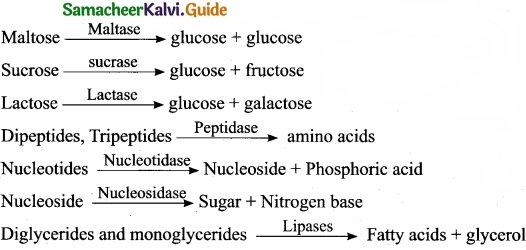
The mucus along with the bicarbonate ions from the pancreas provides an alkaline medium (pH 7.8) for the enzymatic action. As a result of digestion, all macromolecules of food are converted into their corresponding monomeric units.
- Carbohydrates → monosaccharides
(glucose, fructose, galactose) - Proteins → amino acids
- Lipids → fatty acids and glycerol
The simple substances thus formed are absorbed in the jejunum and ileum region of the small intestine. The undigested and unabsorbed substances are propelled into the large intestine.
The activities of the gastro – intestinal tract are carried out by the neural and hormonal control for proper coordination of different parts. Gastric and intestinal secretions are stimulated by neural signals. Hormonal control of the secretion of digestive juices is carried out by local hormones produced by the gastric and intestinal mucosa.
![]()
Question 21.
Explain the types of movement?
Answer:
The different types of movements that occur in the cells of our body are amoeboid, ciliary, flagellar and muscular movement.
Amoeboid movement:
Cells such as macrophages exhibit amoeboid movement for engulfing pathogens by pseudopodia formed by the streaming movement of the cytoplasm. Ciliary movement – This type of movement occurs in the respiratory passages and genital tracts which are lined by ciliated epithelial cells.
Flagellar movement:
This type of movement occurs in the cells which are having flagella or whip – like motile organelle. The sperm cells show flagellar movement.
Muscular movement:
The movement of hands, legs, jaws, tongue are caused by the contraction and relaxation of the muscle which is termed as the muscular movement.
[OR]
What are the major hypothalamic hormones and also explain their functions?
Answer:
